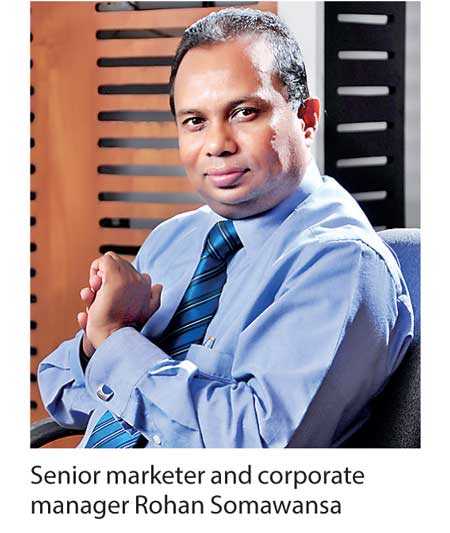Thursday Apr 25, 2024
Thursday Apr 25, 2024
Wednesday, 17 October 2018 00:00 - - {{hitsCtrl.values.hits}}


Senior marketer and corporate manager Rohan Somawansa was unanimously elected as the President of the prestigious Asia Marketing Federation (AMF) for the period of 2018-2020 at its AGM in Guangzhou, China last week. Somawansa presently holds the position of Head of Marketing and Corporate Communication (CMO), and the Director of Samson Trading Company Ltd. and Globe Knitting Ltd. under the highly diversified DSI Samson group, which also happens to be the largest footwear manufacturer and etailer in Sri Lanka. The following are excerpts from an interview with the new President of AMF:
Q: What is the primary role of AMF as an important organisation in Asia?
A: The AMF is the governing body of marketing in Asia. The AMF’s mission is to effectively promote the interests of marketing in Asia in general and strengthen the Asian marketing fraternity. With the belief that ‘marketing for a better Asia is the synthesis of marketing trends in the member countries’, the AMF currently consists of 18 countries, adding the Maldives and Macao this year, and plays a highly active role in ASEAN (Association of Southeast Asian Nations).
I would like to thank all the members of the AMF for their trust in me and also my host marketing institute, Sri Lanka Institute of Marketing (SLIM) for their confidence in me.
Q: What are the previous positions you have held in the AMF?
A: I was appointed as the 2nd Vice President in 2011 and also took on the role of Co-Chairman of the Asia Excellent Marketing Awards, which is the first awards program organised by a professional body in Asia. In 2016/2017 I served as Chairman of the awards program. In 2016 I was honoured to be elevated to the position of 1st Vice President. I carried out my responsibilities as 1st Vice President until I was elected President this year. I was also a member of the AMF Education Committee as well.
Q: With powerful economies like Japan, China and Korea, how do you plan to achieve your vision for the AMF and the AMF’s vision for Asia?
A: Asia represents 60% of the world market, while the South-East Asian countries and South Asian countries together represent nearly 35%. As a whole, the small number of developed economies and developing markets, as well as the large number of less developed Asian countries with diverse politics, economies, cultures, legal frame work and technological penetration, are the challenges faced by the ‘Marketing for a better Asia’ concept. I intend to focus on a few strategic fillers as follows to bridge this gap:
1. Connecting SMEs via chambers and national marketing institutes to find business opportunities. SMEs currently contribute to more than 50% of GDP of most Asian economies.
2. Better support to boost national brands to the status of regional brands as Asia is far behind in comparison with the US and Europe.
3. Adding new members, especially from the SARCC region. SARCC represent a big market when compared to ASEAN, hence its contribution to Asia is most important.
4. Introduce more educational products to uplift business and marketing knowledge, especially for LDCs and some developing markets. We have good Asian educational products and case studies.
5. Appreciate and recognise the best marketing practices in Asia through awards programs and recognise Asian women, youth and digital practitioners in management, this will help those organisations to plan their development in and beyond Asia.
Q: How do you perceive the strength of marketing in the ASEAN and SAARC?
A: As an important trade block for whole world, the Association of Southeast Asian Nations (ASEAN) has a common goal for marketing. During its 50th anniversary celebration last year in Jakarta, the AMF announced its plan to focus on SME development, as the sector is as an important contributor to the ASEAN economy. Unfortunately, we still do not have a common plan in the SAARC region. My aim is to develop the same practices as the ASEAN in the SAARC region and further extend it to intra trade blocks in order to gain benefits for SME and National brands. However, in the case of prospective brand development there are Asian brands such as Singapore Airlines that have now become global brands, while brands such as TATA are still in the transition stage.
Q: What is the current status of brand development in the rest of Asia?
A: Japan and Korea have already developed great global brands. China is currently enthusiastically developing brands via a vigorous development process, adopting new management practices and creating such a culture within their education system. Huawei is a Chinese global brand that is currently growing in popularity.
Q: Explain the significance of your appointment to Sri Lanka?
A: My role will definitely help me to create a better platform for business development in my country, especially when it comes to tourism and the SME development program with SLIM as well as other stake holder institutes in Asia.
Q: What are the other important changes that took place at the AGM of the AMF?
A: The current President of SLIM and CEO of Lanka Hospital Diagnostics Ltd. Pradeep Edward and the eminent Past President of SLIM and Director of Chisel Holdings Ltd. Ruwan Liyanagamage were appointed as Secretary Generals of the AMF at the same meeting.
The distinguished Professor Kim Boojong from Korea and Jack Yao Xing, the Deputy Director General of CCIPT, the organisation responsible for the promotion of Chinese goods and services to the world and vice versa, were elected as 1st and 2nd Vice Presidents of AMF respectively.